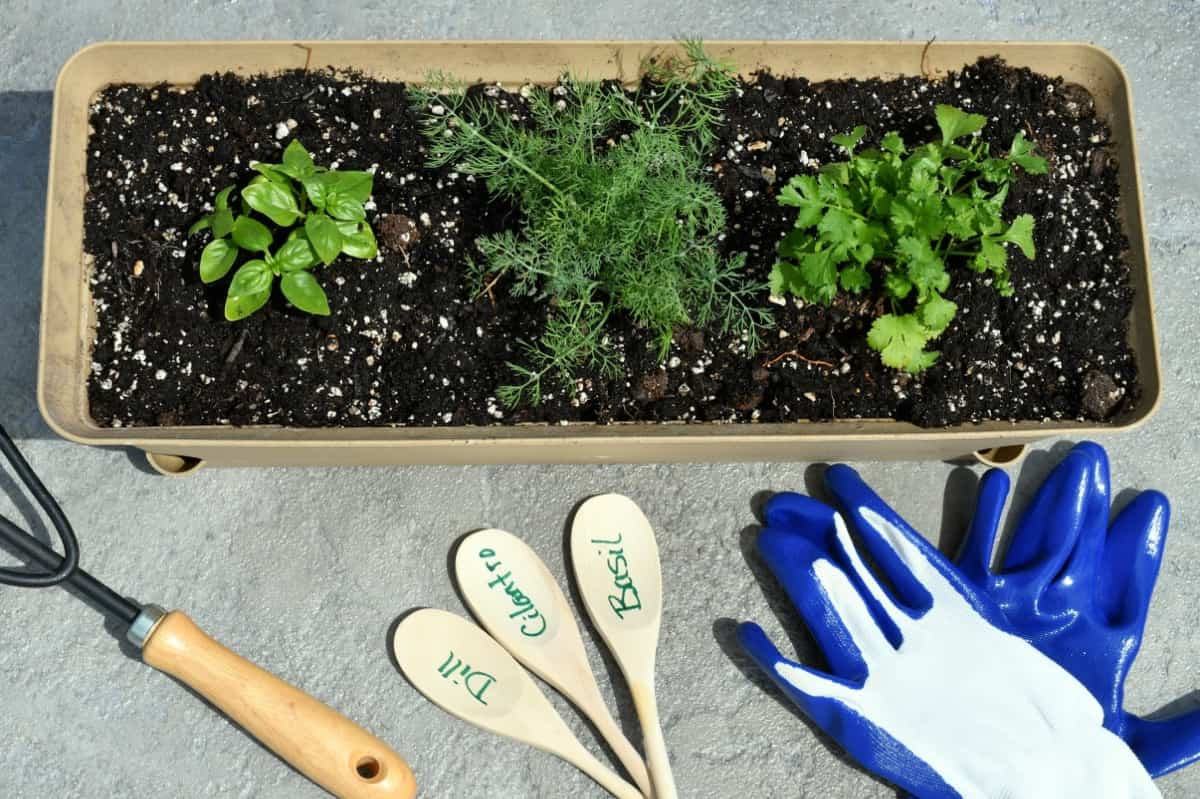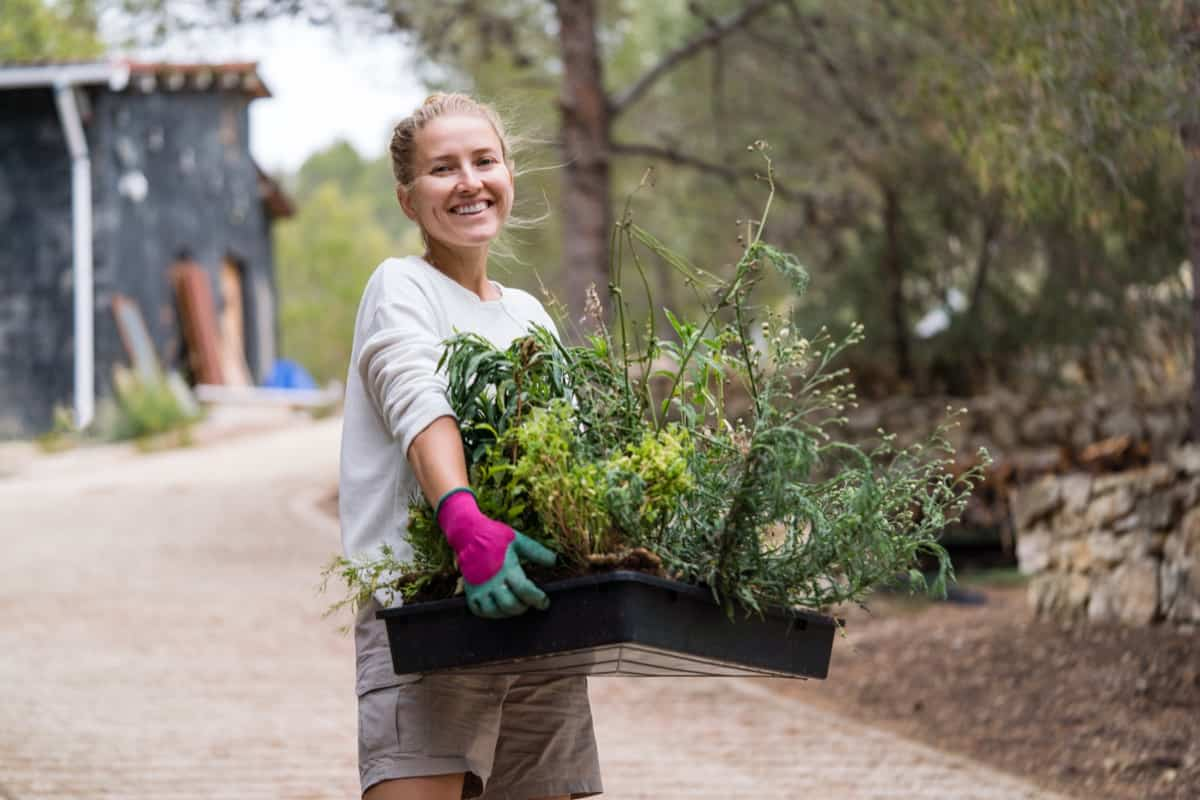Companion planting is the practice of growing fruits, vegetables, flowers, and herbs together to benefit one another. The time you spend weeding, watering, fertilizing, and otherwise caring for your plants can be reduced by planting certain species together that offer certain benefits. Several plants possess pest-repellent properties that protect vulnerable plants from bugs.

The roots of some plants fix certain nutrients into the soil (beans, for example), allowing them to be more readily available to your other plants. Companion planting is a great method to maximize your garden space.
Companion Planting in Container Gardening
Reasons to Utilize Companion Planting in Containers
A container garden is an easy, quick way to grow vegetables, herbs, and fruits right on your doorstep while saving space. Container gardening reduces your overall weeding and pest control chores and takes up much less space and time than a regular garden. To maximize the benefits of containers, you should place your plants strategically to complement and benefit each other. As a result of companion planting in containers, you can reduce the rate of pest infestations and diseases and significantly increase your yields.
Popular and Most Successful Companion Planting Combinations
| Plant / Crop name | Companion Plants |
| Asparagus | Tomatoes, Basil, Parsley, Dill, Coriander, Marigolds |
| Basil` | Tomatoes, Peppers, Oregano, Parsley, Asparagus, Chamomile |
| Beans | Corn, Cucumbers, Peas, Potatoes, Marigolds, Nasturtiums |
| Beets | Onions, Bush Beans, Lettuce, Cabbage, Radishes, Marigolds |
| Broccoli | Onions, Potatoes, Dill, Chamomile, Sage, Thyme, Rosemary |
| Brussels Sprouts | Beans, Beets, Celery, Dill, Onion, Thyme, Rosemary, Sage |
| Cabbage | Beans, Celery, Dill, Onions, Chamomile, Mint, Thyme, Rosemary |
| Carrots | Tomatoes, Peas, Radishes, Lettuce, Onions, Rosemary, Sage |
| Cauliflower | Beans, Celery, Peas, Spinach, Oregano, Chamomile, Thyme, Rosemary |
| Celery | Cabbage, Tomatoes, Leeks, Bush Beans, Cosmos |
| Corn | Beans, Peas, Cucumbers, Squash, Pumpkins, Sunflowers |
| Cucumbers | Beans, Corn, Peas, Radishes, Sunflowers, Nasturtiums |
| Eggplant | Peppers, Beans, Spinach, Thyme, Marigolds, Tarragon |
| Garlic | Tomatoes, Peppers, Spinach, Cabbage, Broccoli, Kale, Dill |
| Kale | Beets, Onions, Celery, Herbs (Dill, Sage, Thyme, Rosemary) |
| Leeks | Carrots, Celery, Onions, Spinach, Cabbage, Marigolds |
| Lettuce | Carrots, Onions, Radishes, Strawberries, Cucumbers, Dill |
| Melons | Corn, Sunflowers, Radishes, Nasturtiums, Marigolds |
| Onions | Carrots, Tomatoes, Peppers, Lettuce, Strawberries, Chamomile |
| Peas | Beans, Carrots, Corn, Cucumbers, Radishes, Turnips, Mint |
| Peppers | Basil, Onions, Spinach, Carrots, Marigolds |
| Potatoes | Beans, Peas, Corn, Cabbage, Marigolds, Horseradish, Nasturtiums |
| Pumpkins | Corn, Beans, Peas, Sunflowers, Oregano |
| Radishes | Carrots, Peas, Lettuce, Spinach, Cucumbers, Nasturtiums |
| Spinach | Peas, Radishes, Strawberries, Chard, Eggplants, Cabbage |
| Strawberries | Lettuce, Spinach, Borage, Caraway, Thyme, Sage |
| Sunflowers | Corn, Cucumbers, Melons, Squash, Pumpkins, Nasturtiums |
| Swiss Chard | Radishes, Spinach, Lettuce, Beans, Lavender |
| Tomatoes | Basil, Carrots, Marigolds, Onions, Lettuce, Asparagus |
| Zucchini | Corn, Peas, Radishes, Spinach, Onion, Marigolds |
Companion Planting Tips in Containers
Choose Compatible Plant Pairs: Complementary growth habits and needs should be considered when choosing plants for companion gardening. Consider pairing plants with different root depths to prevent competition for nutrients or water or growing tall plants with shade-tolerant ones.
In case you missed it: How to Avoid Common Mistakes in Container Gardening

Utilize Pest-Repellent Plants: Use plants such as marigolds, basil, and lavender in your garden with natural pest-repelling properties. These plants help deter unwanted insects and pests, reducing the need to use chemical pesticides in the garden and promoting a healthier ecosystem.
Optimize Nutrient Availability: Nutrient-rich Species, such as legumes, should be planted alongside those that require nitrogen, such as corn or leafy greens. In addition to improving soil fertility, legumes fix nitrogen from the atmosphere, allowing it to be used by nearby plants.
Practice Crop Rotation: Make sure you rotate your companion planting groups every season or every year. By doing this, the soil can replenish its nutrients, preventing the buildup of pests and diseases specific to certain plant families.
Embrace Diversity: You can attract beneficial insects by planting different plants with different colors, textures, and scents. Biodiversity contributes to a more balanced and resilient garden ecosystem more resistant to environmental stress.
Consider the Nutrient Requirements of Each Plant: The nutrient requirements of different plants vary. When arranging the varieties in your pot, matching plants with similar water and fertilizer requirement is essential. Plants that require much water, such as cucumbers, will never grow successfully alongside herbs like rosemary, which prefer drier conditions.
Sunlight Requirements Also Keep in Mind: Before putting plants together, ensure you understand how much sunlight they require. If you have a large container, plant a tall plant with large leaves covering smaller ones that prefer to be closer to the soil.
Companion Plantings to Avoid
Almost any plant can be planted together, but there are a few combinations you should avoid. Some plants have allelopathic properties, which means they release chemicals and compounds around them that specifically kill plants around them. Other plants don’t mix well with others because they have similar nutritional needs and can easily overcrowd a small space. By planting them together, you will double your risk of infestation since they attract similar types of pests. Containers should not be planted with these combinations:
- Carrots with dill
- Beans with garlic
- Onions with beans
- Fennel with carrots
- Tomatoes with potatoes
- Potatoes with squash
- Onions with peas
Benefits of Companion Planting in Container Gardening
- Deterring Pests: Some plants repel insects or deter critters. Many pests dislike the smell of garlic, for instance.
- Attracting Beneficials: Beneficial insects are also attracted to some plants. Borage, for instance, attracts pollinating bees and tiny pest-eating wasps.
- Shade Regulation: Shade is provided by large plants for smaller plants needing sun protection. Lettuce, for instance, is shaded by corn.
- Natural Supports: A tall plant like corn or sunflower can support lower-growing, sprawling crops like cucumbers and peas.
- Improved Plant Health: One plant may alter the soil biochemistry in favor of nearby plants if it absorbs certain substances from the soil.
- Improving Soil Fertility: Several crops, such as beans, peas, and legumes, make nitrogen more accessible to the soil. Similarly, plants with long taproots, such as burdock, pull nutrients from the soil, enriching the topsoil for shallow-rooted plants.
- Weed Suppression: Crops like sprawling potatoes are best planted with tall, upright plants to minimize open areas where weeds can grow.
In case you missed it: Best Potting Soil and Fertilizers for Container Gardening

Conclusion
Planting companion plants in your container garden is one of the best possible ways to maximize its potential. By grouping plants with similar water, light, and nutrient requirements, you can ensure each vegetable gets the resources it needs to thrive. In addition, companion plants can serve as food sources for beneficial insects or discourage pests. The addition of companion planting in containers to any garden can be successful with careful planning, research, and execution.
- Ultimate Guide to Ossabaw Island Hog: Breeding, Raising, Diet, and Care
- Ultimate Guide to Juliana Pig: Raising Facts, Size, Diet, Care, and Lifespan
- Raising Lleyn Sheep: Disadvantages, Price, Uses, Characteristics, and Care
- Ultimate Guide to Meishan Pig: Breed Facts, Breeding, Raising, and Care
- Ultimate Guide to Teacup Pigs: Raising, Diet, Lifespan, Cost, and Care
- Guide to Raising Poll Dorset Sheep: Facts, Profile, Characteristics, Uses, and Care
- Ultimate Guide to Bighorn Sheep: Characteristics, Diet, Lifespan, Breeding, and Lifecycle
- Ultimate Guide to Raising Katahdin Sheep: Farming Facts, Breed Profile, Uses, and Care
- Ultimate Guide to Raising Oreo Cows: Belted Galloways Farming Facts, Profile, Uses, and Care